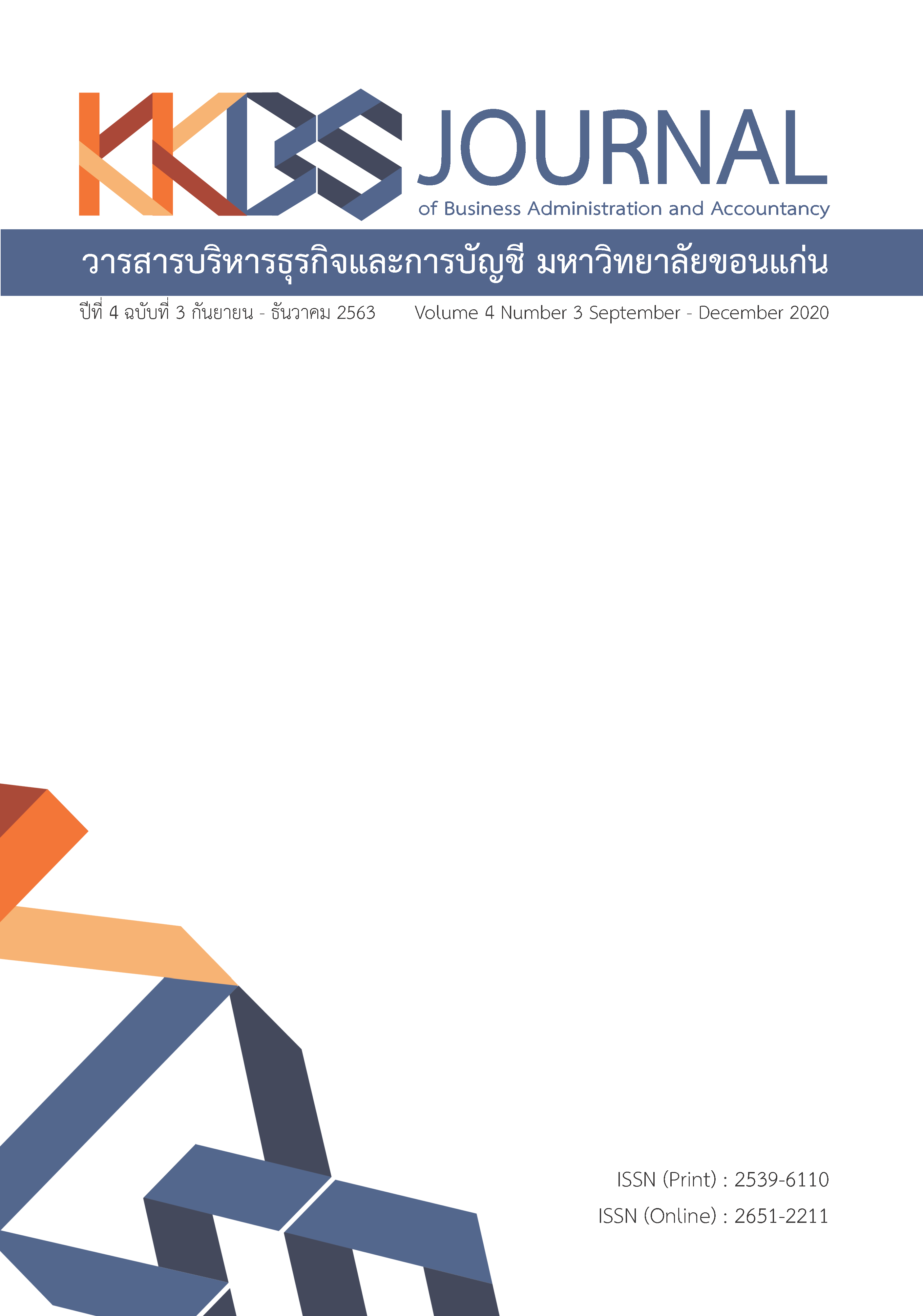Employees’ Innovative Work Behavior Model in Electrical and Electronics Industry at Industrial Estate of Chonburi Province
Main Article Content
Abstract
The objectives of this research were to develop and inspect causal model of employees’ innovative work behavior in electrical and electronics industry at industrial estate of Chonburi province with empirical data. The sample in this study was employees in supervisor level of electrical and electronics industry at industrial estate, Chonburi province. The 300 samples were obtained from infinite population and considered by number of observed variables. Data were analyzed by using Structural Equation Model (SEM). The results of the study showed that organizational structure, organizational culture and knowledge sharing had direct effect on the employees’ innovative work behavior. Organizational structure and the organizational culture had indirect effects on employees’ innovative work behavior mediated by knowledge sharing. Leader had indirect effect on employees’ innovative work behavior mediated by organizational structure, organizational culture and knowledge sharing. In addition, leader, organizational structure, organizational culture and knowledge sharing could predict employees’ innovative work behavior in electrical and electronics industry at industrial estate of Chonburi province. The predictive ability is 38 percent (R2 = 0.38). Therefore, for employees’ innovative work behavior promotion, leaders must to play a critical role to designing work structure, work culture, and work knowledge sharing activities.
Article Details
The articles published in the journals are the authors' opinions, not the opinion of the editorial team or administrative staff. The articles published is copyright of the Journal of Business Administration and Accounting, Khon Kaen University.
References
Allen, K.R. (2011). New venture creation. 6th ed. Nashville: South-Western.
Andreeva, T. & Kianto, A. (2011). Knowledge processes, knowledge-intensity and innovation: a moderated mediation analysis. Journal of Knowledge Management, 15(6), 1016-1034.
Charoenwongsak, K. (2012). The Clue of the thinker. Bangkok: Success Media. (In Thai)
Cheung, M.F. & Wong , C.-S. (2011). Transformational leadership, leader support, and employee creativity. Leadership & Organization Development Journal, 32(7), 656-672.
Costa, V. (2016). Key knowledge management processes for innovation: a systematic literature review. Journal of Information and Knowledge Management Systems, 46(3), 386-410.
Chumkesornkulkit, P. & Na Wichian, S. (2018). Innovative work behavior: concept, antecedents and challenges. Journal of Behavioral Science for Development, 10(1), 25-41. (In Thai)
Daugherty, P.J., Chen, H. & Ferrin, B.G. (2011). Organizational structure and logistics service innovation. The International Journal of Logistics Management, 22(1), 26-51.
Dechawattanapaisal, D. (2012). Personality type and creative thinking: A study of architectural design professionals. Chulalongkorn Business Review, 34(1), 89-106. (In Thai)
De Jong, J.P. & Den Hartog, D.N. (2007). How leaders influence employees' innovative behaviour. European Journal of Innovation Management, 10(1), 41-64.
Dyer, J.H., Gregersen, H. & Christensen, C.M. (2011). The innovator's DNA: Mastering the five skills of disruptive innovators. Massachusetts: Harvard Business Review.
Electrical and Electronic Institute. (2018). Electrical and Electronic Institute. Retrieved December 2, 2018, from http://www.thaieei.com/eiu/TableauPage.aspx?MenuID=35. (In Thai)
Hair et al. (2010). Multivariate data analysis. Harlow: Pearson Education.
Han, Y. & Chen, G. (2018). The relationship between knowledge sharing capability and innovation performance within industrial clusters: Evidence from China. Journal of Chinese Economic and Foreign Trade Studies, 11(1), 32-48.
Hansen et al. (2002). Creating a strategy to manage knowledge. Massachusetts: Harvard Business Press.
Higgins, J.M. (1995). How effective innovative companies operate lessons from Japanese strategy. Creativity and Innovation Management, 4(2), 110-119.
Ikeda, K. & Marshall, A. (2016). How successful organizations drive innovation. Strategy & Leadership, 44(3), 9-19.
Kheng, Y.K., Mahmood, R. & Beris, S.J. (2013). A Conceptual review of innovative work behavior in knowledge intensive business services among knowledge workers in Malaysia. International Journal of Business, Humanities and Technology, 3(2), 91-99.
Kuczmarski, T.D. (2003). What is innovation? And why aren’t companies doing more of it? Journal of Consumer Marketing, 20(6), 536-541.
Lee, H.-W. & Yu, C.-F. (2011). Effect of organizational relationship style on the level of knowledge sharing. International Journal of Manpower, 32(5/6), 677-686.
Limmanont, P. (2008). Strategic business innovation management for change. Bangkok: Pharinas. (In Thai)
Mathisen, G.E., Einarsen, S. & Mykletun, R. (2012). Creative leaders promote creative organizations. International Journal of Manpower, 3(2), 367-382.
Ministry of Commerce. (2020). Export structure of Thailand. Retrieved March 17, 2020, from http://tradereport.moc.go.th/Report/Default.aspx?Report=MenucomRecode&ImExType=1&Lang=Th (In Thai)
Niyom, P., Satyarakwit, S. & Imsombut, A. (2015). Knowledge sharing in large businesses in Thailand. Suthiparithat, 26(79), 63-90. (In Thai)
Numprasertchai, S. (2015). Knowledge management. Bangkok: Se-Ed. (In Thai)
Office of the Public Sector Develobment Commission and Thailand Productivity Institute. (2005). Knowledge management: from theories to practice. Bangkok: K. Pon (1996) Printing. (In Thai)
Pakdeelao, W. (2011). The study of characteristics of innovative organization : case studies from awarded organizations. Bangkok: National Institute of Development Administration. (In Thai)
Phucharoen, W. (2007). Sustainable and self-sufficient innovation. Bangkok: Ariya Chon. (In Thai)
Sadangharn, P. (2016). Innovative in HR. People Magazine, 36(1), 72-75. (In Thai)
Saenz, J., Aramburu, N. & Blanco, C.E. (2012). Knowledge sharing and innovation in Spanish and Colombian high-tech firms. Journal of Knowledge Management, 16(6), 919-933.
Sharifirad, M.S. & Ataei, V. (2012). Organizational culture and innovation culture: exploring the relationships between constructs. Leadership & Organization Development Journal, 33(5), 494-517.
Silpjaru, T. (2017). Statistical research and analysis with SPSS and AMOS. 17th ed. Bangkok: Business R&D. (In Thai)
Sivapitak, S., Sriworawilai, N. & Na Ubon, A. (2011). Innovation management of business organization affecting employees’innovative work behavior. BU Academic, 11(1), 37-51. (In Thai)
Soonthonsmai, V. (2009). Marketing research and marketing information systems. Bangkok: Technology Promotion Association (Thailand-Japan). (In Thai)
Stamm, B.V. (2008). Managing innovation, design and creativity. New Jersey: Wiley.
Tuntrabundit, K. (2018). Innovative and creative management. Khon Kaen: Khon Kaen Printing. (In Thai)
Valencia, J.C., Valle, R.S. & Jimenez, D.J. (2010). Organizational culture as determinant of product innovation. European Journal of Innovation Management, 13(4), 466-480.
West, M. & Farr, J. (1989). Innovation at work: Psychological perspectives. Social Behavior, 4(1), 15-30.
Wutthirong, P. (2016). HR in the next decade. Bangkok: Chulalongkorn University Printing House. (In Thai)
Yotyingyong, K. (2009). Innovative organization: concept and process. Bangkok: Chulalongkorn University Printing House. (In Thai)
Zhou et al. (2018). Visionary leadership and employee creativity in China. International Journal of Manpower, 39(1), 93-105.


